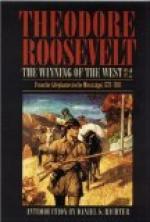All the Northwestern Tribes go to War.
All through the winter of ’76-77 the northwestern Indians were preparing to take up the tomahawk. Runners were sent through the leafless, frozen woods from one to another of their winter camps. In each bleak, frail village, each snow-hidden cluster of bark wigwams, the painted, half-naked warriors danced the war dance, and sang the war song, beating the ground with their war clubs and keeping time with their feet to the rhythmic chant as they moved in rings round the peeled post, into which they struck their hatchets. The hereditary sachems, the peace chiefs, could no longer control the young men. The braves made ready their weapons and battle gear; their bodies were painted red and black, the plumes of the war eagle were braided into their long scalp locks, and some put on necklaces of bears’ claws, and head-dresses made of panther skin, or of the shaggy and horned frontlet of the buffalo. [Footnote: For instances of an Indian wearing this buffalo cap, with the horns on, see Kercheval and De Haas.]
Before the snow was off the ground the war parties crossed the Ohio and fell on the frontiers from the Monongahela and Kanawha to the Kentucky. [Footnote: State Department MSS. for 1777, passim. So successful were the Indian chiefs in hoodwinking the officers at Fort Pitt that some of the latter continued to believe that only three or four hundred Indians had gone on the war path.]
On the Pennsylvanian and Virginian frontiers the panic was tremendous. The people fled into the already existing forts, or hastily built others; where there were but two or three families in a place, they merely gathered into block-houses—stout log-cabins two stories high, with loop-holed walls, and the upper story projecting a little over the lower. The savages, well armed with weapons supplied them from the British arsenals on the Great Lakes, spread over the country; and there ensued all the horrors incident to a war waged as relentlessly against the most helpless non-combatants as against the armed soldiers in the field. Block-houses were surprised and burnt; bodies of militia were ambushed and destroyed. The settlers were shot down as they sat by their hearth-stones in the evening, or ploughed the ground during the day; the lurking Indians crept up and killed them while they still-hunted the deer, or while they lay in wait for the elk beside the well-beaten game trails.
The captured women and little ones were driven off to the far interior. The weak among them, the young children, and the women heavy with child, were tomahawked and scalped as soon as their steps faltered. The able-bodied, who could stand the terrible fatigue, and reached their journey’s end, suffered various fates. Some were burned at the stake, others were sold to the French or British traders, and long afterwards made their escape, or were ransomed by their relatives. Still others were kept in the




